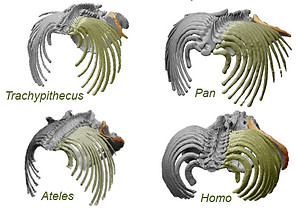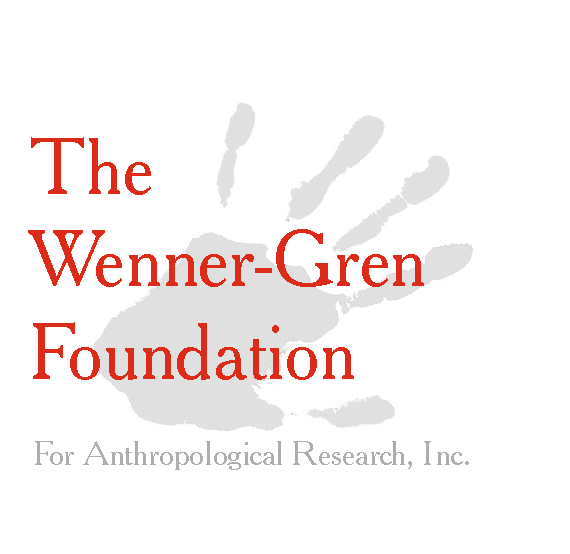Ward Lab @ University of Missouri
Ape and human functional anatomy and evolution, Department of Pathology & Anatomical Sciences
3D Biomechanics of Grasping in Primates and other Mammals
The latest research projects in our lab address the biomechanics of grasping in the hands and foot of primates and other mammals. Being able to grasp supports with the hands and feet affords large mammals the ability to exploit arboreal environments, which provide ample food resources and protection from predators, but is mechanically challenging to move within as substrates are variable in size, orientation, compliance and distribution. Using developments in analyzing contrast-enhanced soft tissue morphology pioneered by Drs. Casey Holliday and Kevin Middleton, we are applying a workflow that allows us to visualize, quantify and compare the orientation of each muscle in 3D, explore their soft and hard tissue attachments. This ability applies to each fascicle of our muscles, allowing us to quantify force-generating capacity of the muscle as a whole, as well as orientatinos and lengths of the individual fascicles that make up a muscle. We have recently been funded by the Leakey Foundation to explore the 3D biomechanical capacity for grasping in chimps, gorillas and humans.




Torso Morphology in Anthropoids
The hominoid torso has changed substantially throughout hominoid evolution, and is related to locomotor and postural adaptations. Changes in torso structure, and the morphology of its skeletal elements, are key to reconstructing the evolution and adaptations of hominoids, and the origin of hominins. Through a combination of CT scans, landmark coordinates, photos, caliper measurements and 3D laser scans, we are studying the interrelations among elements and the structure of the torso in extant and fossil anthropoids to better understand Miocene hominoids and their evolutionary history. This research is funded by the National Science Foundation (BCS 0716244).




Evolution & biomechanics of mandibular form in Australopithecus anamensis & A. afarensis
This project is a collaboration with Drs. Callum Ross, Bill Kimbel, Andrea Taylor, Chris Robinson, and Zeray Alemseged funded by NSF (BCS 1515719). The evolution of feeding behavior and diet in our early ancestors is a central problem in human origins research. The primary focus of the proposed research is an integrative investigation of how spatial and mechanical determinants of mandibular form track change in diet and feeding behavior in extant hominids (great apes+humans) and early Australopithecus. The research is organized under three specific aims: 1. Quantifying and comparing the location, magnitude and nature of external and internal morphological variation in mandibles of extant (Homo, Pongo, Pan, and Gorilla) and fossil (A. anamensis, A. afarensis) hominids via computed tomography and geometric morphometrics. 2. Testing specific hypotheses about the biomechanical significance of variation in hominid mandibular morphology via finite-element models. 3. Evaluating the extent to which spatial positioning of masticatory system components (tooth row, jaw joint, and muscle attachment points) explain variation in mandibular morphology across extant hominids and early Australopithecus.





Renewed field investigations of Pliocene localities at Lomekwi, West Turkana, Kenya




This four year project is to conduct paleontological fieldwork at Lomekwi, West Turkana, Kenya (3.5-3.3 million years old) as part of the West Turkana Paleo Project. We have just completed our first season. Lomekwi is the site that yielded Kenyanthropus platyops, which was the first evidence of possible Pliocene hominin diversity. In 2015 it also yielded earliest stone tools, that date to more than a half a million years before the origin of Homo. The appearance of stone tools and hominin diversity raises questions about local or regional environmental and/or biogeographic factors that may have influenced hominins in West Turkana in the mid-Pliocene. Finding more fossils at Lomekwi stands to reveal how many hominins were present at that time, whether K. platyops is indeed a valid taxon, who the Lomekwian tool makers may have been, and what paleoenvironmental factors may have influenced their diversity and behavior. This work is funded by NSF (BCS 1551992), the University of Missouri Research Board, and the Wenner Gren Foundation for Anthropological Research.




Non-landmarked based 3D morphometrics
When working with fossils, paleontologists often do not have the luxury of complete specimens with which we can quantify morphology using traditional linear or landmark data. With Dr. Mike Plavcan’s lab and the Center for Advanced Spatial Technologies at University of Arkansas, we are using continuous laser scan data to develop ways of quantifying morphology without the use of landmarks as part of several projects in the lab. We have published some of this work with Dr. Ashley Hammond, and have more papers to come. These methods are also useful for comparing morphology in 3D that has continuous or rounded contours. This research is funded by the Wenner Gren Foundation and the LSB Leakey Foundation.







Koobi Fora hominin postcrania
I am working on editing a monograph with co-editors Drs. Ashley Hammond, Habiba Chirchir and Carrie Mongle on the Koobi Fora hominin postcranial fosssils as part of the Koobi Fora Research Project series to be published through Oxford University Press. There are over 80 postcranial fossils from perhaps as many as four species of hominins dated to between about 2.0 and 1.5 million years ago at Koobi Fora. Most are unassociated with cranial remains. These fossils give us important insights into the evolution and diversity of hominin body form in the early Pleistocene. have inmpoThis monograph presents the fossils, and assesses the variability and morphology and size within this sample to make better inferences about hominin evolution in East Africa during this time period.





Sterkfontein hominin postcranial fossils

Following an effort originally started by the late Dr. Charlie Lockwood, I also co-organized the Sterkfontein hominin postcranial workshop a few years ago that is now being completed as a monograph for Oxford University Press, to be completed this year. This monograph presents and describes this large collection of fossils, many of which have been under-studied or never formally described. This effort involves international team of researchers who met at the University of the Witswatersrand for 5 days of study and discussion of the fossils. The effort has been funded by the Wenner Gren Foundation, PAST, George Washington University NSF IGERT, and Ford Foundation.



© 2020 by Carol V Ward

